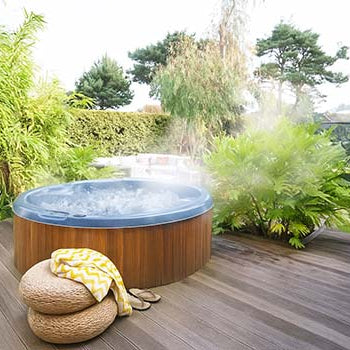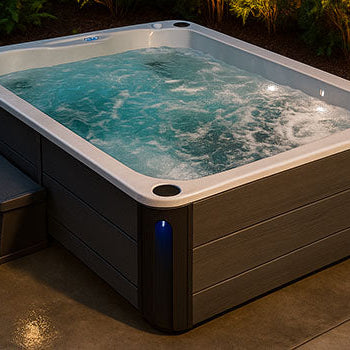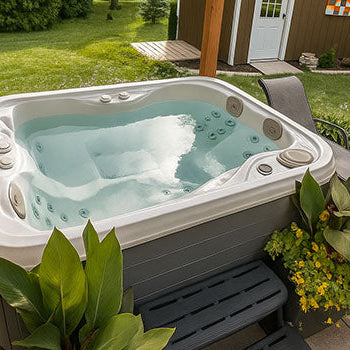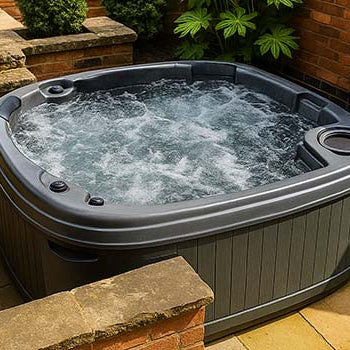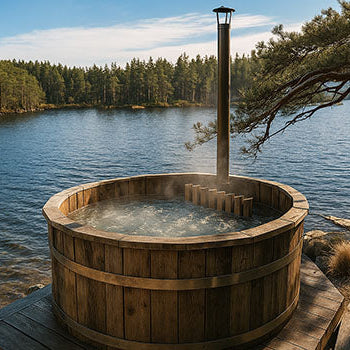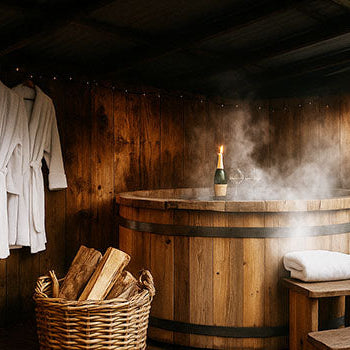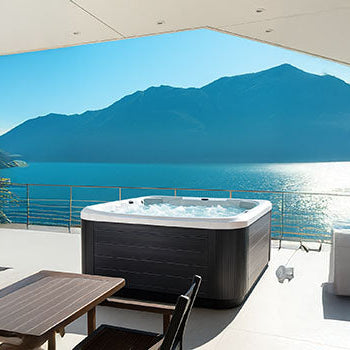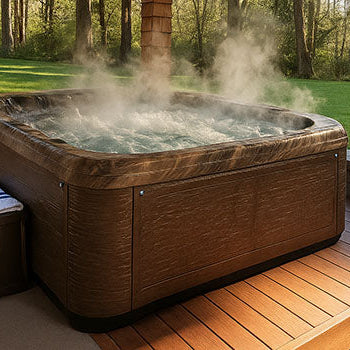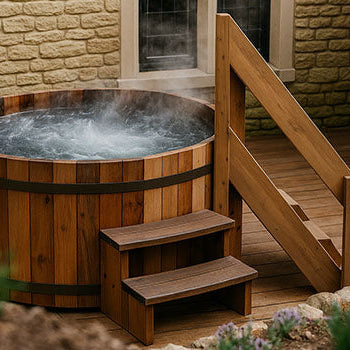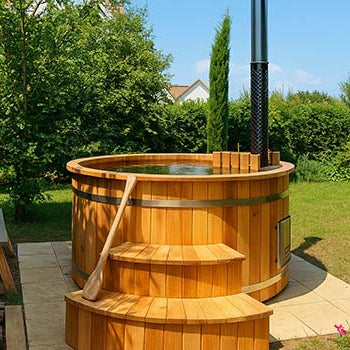Wondering what chemical you need for a hot tub? Short answer: you’ll need a sanitiser, pH balancer, shock treatment, alkalinity booster, and a few extras depending on your water. Acrylic Hot Tubs usually handle chlorine well. Rotomoulded ones lean toward gentler care. And Wooden Hot Tubs? They're better off with more natural-friendly options. Keep reading to learn which chemicals suit your spa, and how to keep it sparkling all year round.

Why Hot Tub Chemicals Are Necessary
Keeping Water Safe and Free from Bacteria/Viruses
Hot tubs are warm and inviting, not just for you, but for bacteria too. Without chemicals, that relaxing soak can quickly become a breeding ground for germs.
Sanitisers are your first line of defence. They kill harmful bacteria and keep your water safe to dip into anytime.
Maintaining Water Clarity and Preventing Issues (Cloudiness, Foam)
Cloudy water, weird smells, and foamy bubbles are all signs that your water’s crying out for help. A proper chemical routine keeps the water crystal clear and fresh.
Nobody wants to soak in soup. Stay ahead with the right balance.
Protecting Hot Tub Components from Damage (Corrosion, Scale)
Think of chemicals as armour for your spa. If the water’s too acidic or too hard, it’ll eat away at your jets, pipes, and heater.
Balanced water = a longer-lasting hot tub. And less cash spent on repairs.
Essential Chemical #1: Sanitiser (Killing Germs)
Chlorine Granules/Tablets: Pros and Cons
Chlorine works fast. It’s powerful, reliable, and affordable. That’s why it’s a go-to for many Acrylic Hot Tubs.
Pros: Rapid action, widely available
Cons: Strong scent, may irritate sensitive skin
It’s perfect if you use your tub often and want something that does the job quickly.
Bromine Granules/Tablets: Pros and Cons
Bromine is the chill cousin of chlorine. It’s gentler on skin, works better in hot water, and doesn’t smell as strong.
Pros: Great for Wooden Hot Tubs or indoor spas, longer-lasting
Cons: Slower to act, costs a bit more
Ideal for anyone with sensitive skin, or anyone who just hates the chlorine smell.
Choosing Between Chlorine and Bromine for UK Use
In the UK, cooler temps and variable usage mean bromine’s becoming popular. But chlorine still wins out for outdoor and Acrylic Hot Tubs.
The choice comes down to personal comfort, budget, and how often you soak.
Maintaining Correct Sanitiser Levels
Check levels 2–3 times per week, especially after heavy use.
Targets:
-
Chlorine: 3–5 ppm
-
Bromine: 4–6 ppm
Too little? Germs grow. Too much? Your skin pays the price.

Essential Chemical #2: pH Balancers
Understanding pH Importance (Scale 0–14, Ideal Range 7.2–7.8)
pH is like your water’s mood. If it’s too low, the water is acidic and can sting. Too high? It’s alkaline and makes the water cloudy or flaky.
Keep it between 7.2 and 7.8 for smooth, comfortable soaks.
pH Plus (pH Increaser / Soda Ash)
When your water’s pH dips too low, pH Plus brings it back into balance. Especially helpful in soft water areas.
You’ll likely need this after a refill or heavy use.
pH Minus (pH Decreaser / Dry Acid)
If your pH shoots too high, reach for pH Minus. This helps prevent scale build-up and protects your spa components.
Always adjust in small doses; slow and steady wins this race.
Testing and Adjusting pH Levels
Test your water weekly, or more if the spa’s used often.
Make small changes, then retest.
Don’t eyeball it; use strips or a testing kit to stay in control.
Essential Chemical #3: Alkalinity Balancer
Total Alkalinity (TA) Explained (Buffering pH)
Think of alkalinity as the foundation for your water chemistry. If it’s off, your pH will bounce all over the place.
Stable TA = stable pH = less hassle.
TA Plus (Alkalinity Increaser / Sodium Bicarbonate)
Most UK water runs soft, which means low alkalinity.
TA Plus helps you stabilise your water using sodium bicarbonate, yep, the same stuff in baking soda (but spa-safe!).
Adjusting Alkalinity Before Adjusting pH
Always fix alkalinity before tackling pH. It’s like setting the thermostat before trying to heat the room.
Once TA is in range, pH balancing becomes a breeze.
Essential Chemical #4: Shock Treatment (Oxidiser)
Why Shocking is Needed (Breaking Down Waste, Reactivating Sanitiser)
Over time, hot tubs collect stuff you don’t want to think about, body oils, sweat, and lotions. Shocking breaks it all down and resets your water.
It’s like hitting the refresh button.
Chlorine Shock (Chlorine-Based Sanitisers)
This is your go-to for deep cleans. It works fast and clears up water after heavy use or funky smells.
Perfect for post-party spa rescue missions.
Non-Chlorine Shock (MPS - Suitable for Chlorine or Bromine)
MPS is a gentler, chlorine-free option.
It won’t spike your sanitiser levels, so it’s great for regular upkeep.
Use mid-week or after lighter use.
How Often to Shock Your Hot Tub
Important Chemical #5: Calcium Hardness Increaser
Understanding Calcium Hardness (Protecting Components)
Water that’s too soft pulls minerals from your spa’s parts. That leads to corrosion and pitting.
Adding calcium gives your water a “backbone” and protects internal systems.
Importance of Soft Water Areas of the UK
If you live somewhere with soft tap water (hello, Scotland), this one’s crucial.
Without it, heaters, jets, and pipes wear out faster.
Testing and Adjusting Calcium Hardness Levels
Check the calcium when you fill the tub, and once every few months.
If it’s under 150 ppm, add a Calcium Hardness Increaser to hit the safe zone.

Other Useful Hot Tub Chemicals
Water Clarifiers
These make tiny particles stick together so your filter can catch them.
Use when water looks dull or murky.
One dose can make a huge difference overnight.
Anti-Foam / Defoamer
Foam looks fun, until it doesn’t.
A quick squirt of defoamer clears the bubbles fast, especially if you’ve used bath products or body lotion before soaking.
Hot Tub Flush / Pipe Cleaner
Before draining, give your spa a proper detox.
Flush clears out hidden gunk in the pipes, helping your next refill stay fresher for longer.
Test Strips or Testing Kits (Essential Tool)
Don’t guess, test.
Test strips or kits tell you what your water needs, so you don’t end up overdoing it.
Conclusion: Your Basic Hot Tub Chemical Toolkit for Safe Soaking
Keeping your hot tub clean isn’t about getting fancy; it’s about being consistent.
Stick to the basics: sanitiser, pH and alkalinity balancers, shock, and calcium boost if needed. The rest are nice-to-haves that make maintenance even easier.
Whether you’ve got an Acrylic Hot Tub in the garden, a compact Rotomoulded spa on the patio, or a rustic Wooden Hot Tub under the trees, these essentials apply.
Stay on top of your water care, and you’ll get more life from your hot tub, and more joy from every soak.







